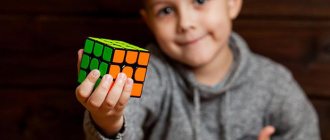I work as a teacher in the “Harmony” kindergarten in the city of Tulun with middle school children. Children of this age (4-5 years old) are very inquisitive, strive to be everywhere, want to try everything during the day of their stay in kindergarten: draw, sculpt, and take part in various role-playing games; they ask adults a lot of questions. It is not for nothing that this age is called the age of “why”. In order for a child to be successful in any activity he is currently involved in, he needs to have a good level of attention. The average preschooler at this age is just beginning to control his attention, that is, the first shoots of voluntary attention are developing. It is well known that children 4-5 years old are very active, mobile, and learn about the world around them through movements. While studying the topic of self-education on the development of attention of children of middle preschool age and studying the literature on this issue, I came to the conclusion that today the authors offer many didactic and printed board games for the development of attention.
I decided to find out whether it is possible to develop children’s attention through outdoor play, since play is a natural need for preschool children. Outdoor play creates more attractive conditions for the development of mental processes, including attention.
Analyzing the behavior of children in physical education classes, it was noticed that they inattentively listen to the teacher’s explanations, violate the rules of the game because they are not careful when explaining them, and conflicts often arise. And there was a need to develop attention in children 4-5 years old specifically in outdoor games.
In middle preschool age, children actively develop the basic properties of attention: switching, volume, concentration, distribution.
And I made a calendar work plan for the week to develop these properties of attention, using outdoor games.
Brief description of the games:
Outdoor games for switching attention:
1. “Catch up with boys and girls” - children are divided into 2 teams - boys and girls, who stand opposite each other, at a distance of 2 m. On a visual reference - a red circle - the girls catch up with the boys, on a reference - a blue circle - the boys catch girls. 2. “At Medvedeivo Bor” - 2 “bears” are selected, which are located on different sides of the site, the rest of the children walk through the forest, “picking mushrooms and berries.” At the signal “bear,” the first leader runs out and catches the children; at the signal “bear,” the second bear runs out and catches. 3. “Multi-colored balls” - children stand in a line. At a distance of 4 m from them, an adult pours out multi-colored balls from a large basket. At the command “collect!” — girls run and collect red and yellow balls, and boys collect green and blue ones. 4. “Quiet-loud” - children run scattered around the playground, when the signal changes (quiet music plays) the children walk on their tiptoes between the pins, when the next signal (fast music) - they jump on two legs over the stumps. 5. “Dragonfly-bugs” - a game similar to the previous one. At the signal of a “dragonfly,” children “fly” around the hall, waving their arms. When the signal is “bugs,” children crawl on their knees.
Outdoor games for attention span:
1. “Who lives in the forest?” - children stand in a circle. Everyone takes turns calling the animal that lives in the forest and showing its movements. The second child in the chain repeats this movement plus shows his own, and so on, all children take turns. 2. “What will we travel on?” — the game is similar to the previous one, but the theme “transport” is taken as the basis. 3. “Traps with colored tails” - all children are given colored ribbons (tails), which they tuck into their belts. One is the driver. His task is to catch a child with a certain color tail. 4. “Ball relay” - 2 teams play, each with a large ball. At the first signal - the wave of the blue flag - you need to pass the ball over your head as a team, then the last player passes the ball back between your legs. 5. “Mirror” - children play in pairs. 1 child from the pair shows any simple movement, and the 2nd child “mirror” copies his movements. Then 1 child shows 2 movements, then 3, the “mirror” child must carefully follow the leader. Then they change roles.
Outdoor games for concentration:
1. “Find your house” - Children stand scattered throughout the hall. Colored hoops are laid out on the floor. There are 2-3 children in each hoop. At the signal “Run” - children run out of their houses, run in all directions, at the signal “Go home!” - children must find a hoop of their color. 2. “Sparrows in houses” - the game is similar to the previous one. But sparrow houses have different shapes: square, round, triangular. Children need to find their own house of a certain shape. 3. “Let’s go to the forest to pick mushrooms” - Mushrooms and nuts cut out of cardboard are laid out on the floor around the hall. Boys turn into “hedgehogs”, girls into “squirrels”. Children run around to the music. At the signal “let’s go to the forest,” boys collect mushrooms, and girls collect nuts. 4. “What is yellow?” — children are divided into 2 teams. The goal of the game is whose team gets to the finish line faster. The distance from the teams to the finish line is 6 child steps. For each step you need to name a yellow object; Moreover, children need to listen carefully to what the other team says - they cannot repeat the named objects. 5. “Berries, mushrooms, leaves” - children line up in a circle, three at a time, one after another. Children must change places with each other according to certain signals: “berries” - the first children from the trio run across; at the signal “mushrooms” - the second participants run across; at the signal “leaflets” - the third participants from the trio.
Outdoor games for the distribution of attention:
1. “Anya, catch the ball” - children stand in a circle, the leader has the ball. He throws the ball to any of the children, while calling his name. Children must listen carefully to whose name the presenter says and have time to catch the ball. 2. “Heels and toes” - children stand in pairs. To cheerful dance music, the teacher points to the socks and the children dance on their toes; if it points to the heels, children stomp their feet. It's better to play in socks. 3. “Do the opposite” - the children stand scattered on the playground. The teacher shows any movement, and the children must show the opposite in response (for example, raises their hands up - they need to lower them, and so on). 4. “Hurry up to change the flag” - children stand scattered, each has a colored flag on a stand at their feet. While the music is playing, children run around the hall between the flags. On the command “blue-red” - children whose flags of the corresponding colors must change their places (by analogy with “yellow-green colors”). 5. “Run to your pins” – pins of different colors are placed in a chaotic manner on the carpet. Each child has a colored circle of a certain color. To the music, children move between the pins without touching them. At the end of the music, everyone should gather at the bowling pins that match the color of the child’s circle.
Systematic work on developing attention will be effective if games are played every day and not occasionally.
Thus, the work carried out showed that children became more attentive and self-controlled when playing outdoor games. They began to notice mistakes made by their peers and explained the rules of the game.
Bibliography:
1. Kozlova, S.A., Kulikova, T.A. — 11th ed., erased. Preschool pedagogy: Textbook for students of secondary educational institutions - M: Publishing House, 2010. - 416 p. 2. Matyugin, I.Yu., Askochenskaya, T.Yu., Bonk I.A. How to develop your child’s attention and memory: A book for children and their parents. - M.: "Eidos", - 1993. 3. Panfilova, M.A. Game therapy of communication, Tests and game correction: A practical guide for psychologists, teachers and parents. - M.: Gnome - Press, 2002 - 160 p. 4. Uruntaeva, G.A. Preschool psychology Preschool psychology: A textbook for secondary school students. - M.: "Academy", 1996. - 336 p.
Author: Ivonina Larisa Alekseevna, teacher, MBDOU “Child Development Center - kindergarten “Harmony”, Tulun, Russia
The article is published in the author's edition
Train now
Train right now on this page, for free and without registration.
Anagrams
Start with anagrams, they will help develop such qualities as: attention, concentration, speed of thought, speed reading. In this game you have to choose 1 option out of 4, in which only those letters that are part of the given word are mixed. Each round a new word is given. Remember that time is limited! The faster you look for the answer, the more points you will get at the end of the game.
Schulte tables
The Schulte table is one of the most effective exercises for developing the brain, attention, concentration, and accelerating visual search. This exercise is also the most popular exercise for developing speed reading. Schulte tables usually consist of randomly placed numbers or letters. The number of cells in tables also varies and most often they are 5x5 elements in size.
Diagnostics of the development of attentional abilities
All aspects of a preschooler’s development, including attention, are carefully analyzed from year to year of his stay in kindergarten. Diagnostics are carried out twice a year: at the beginning (in September, early October) and at the end (in May).
The analysis is carried out on all indicators of attention development: concentration, intensity, stability and switchability. You can view the diagnostic chart for monitoring children aged 2–4 years here; the algorithm for analyzing attention indicators in children aged 5–7 years is presented here. Both monitoring schemes include a table for evaluating the results.
The level of attention development is an important indicator of a child’s readiness for school
Attention training is the fundamental goal of organizing educational activities in kindergarten. Classes aimed at developing and practicing attentional abilities are not included in a separate block of educational activities, but at the initiative of the teacher they can be organized after naps. In general, the indicators laid down by nature, as well as the efforts of the teacher aimed at developing attention in preschool children, are reflected in the results of diagnosing the formation of this form of organization of cognition in children of different ages.






